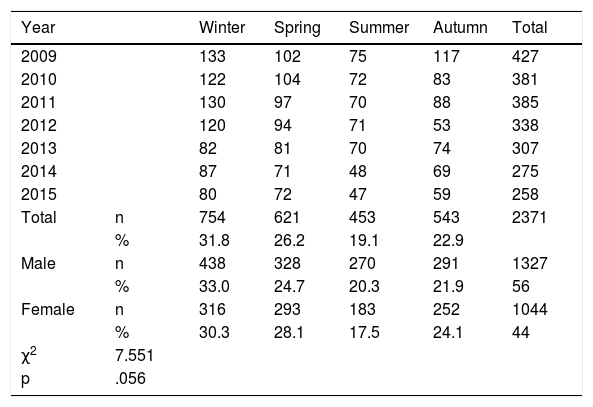Epistaxis is the most common rhinological emergency seen in the emergency department. The purpose of this study was to evaluate epidemiological data of epistaxis in a southern European tertiary care hospital.
MethodsA retrospective study was conducted during the period between January 2009 and December 2015. We analyzed the distribution by cross-referencing the demographic variables, destination after medical discharge, inpatient characteristics (major comorbid diseases, medication, bleeding localization and treatment) and health-care costs with the disease.
ResultsEpistaxis accounted for approximately 1 in 30 visits to the ED and 77 out of a population of 100,000 was served by that ED. Overall, 71,624 patients were treated and 2371 patients presented with epistaxis (3.31%). One-thousand three-hundred and twenty-seven cases were male and 1044 female (p <.001). The mean age was 56 years (±26). Age distribution was bimodal, with peaks among those <10 years and >70 (p <.001). Epistaxis was more common in the winter months (p < 0.001). The main referral destinations (6.8%) included outpatient (2.9%) and inpatient (1.9%) services. Hospitalization was more frequent between the ages of 60 and 80 years (p =.029), and the major comorbidity was hypertension (47.8%). Medication interfering with haemostasis was documented in 30.4%. Most inpatient epistaxis was managed in a non-interventional manner and only. 5% of patients needed surgery. The mean total health-care cost was 69.8 € per episode.
ConclusionEmergency epistaxis was more frequent in men, the elderly, patients with underlying comorbidities, during the winter months, and showed a higher risk of referral and hospitalization with increasing age (as a result of an aging population in western countries). The main hospital expenses for epistaxis are related to hospitalization and health care costs.
La epistaxis es la urgencia rinológica más comúnmente observada en el servicio de urgencias (SU). El objetivo de este estudio es evaluar los datos epidemiológicos de la epistaxis en un hospital de atención terciaria del sur de Europa.
MétodosSe realizó un estudio retrospectivo durante el periodo comprendido entre enero de 2009 y diciembre de 2015. Analizamos la distribución entrecruzando las variables demográficas, el destino tras el alta médica, las características hospitalarias (enfermedades comórbidas mayores, medicación, localización del sangrado y tratamiento) y los costes sanitarios con la enfermedad.
ResultadosLa presentación con epistaxis supuso aproximadamente una de 30 visitas al SU, donde se atendió a una población de 77 de cada 100.000 habitantes. En general se trataron 71.624 pacientes, de los cuales 2.371 se presentaron con epistaxis (3,31%). Mil trescientos veintisiete casos eran varones y 1.044 mujeres (p<0,001). La edad media fue de 56 años (±26). La distribución de la edad fue bimodal, con valores máximos entre ellos <10 años y >70 (p<0,001). La epistaxis fue más común durante los meses invernales (p<0,001). Los principales destinos de derivación (6,8%) incluyeron los servicios ambulatorios (2,9%) y hospitalarios (1,9%). Las hospitalizaciones fueron más frecuentes entre los 60 y 80 años (p=0,029), siendo la hipertensión la mayor comorbilidad (47,8%). La medicación que interfirió con la hemostasia se documentó en el 30,4%. A la mayoría de pacientes hospitalarios con epistaxis se les trató de manera no intervencionista, y únicamente el 0,5% de los casos precisó cirugía. Los costes sanitarios totales medios fueron del 69,8€ por episodio.
ConclusiónLa epistaxis de urgencia fue más frecuente en varones, personas mayores, pacientes con comorbilidades subyacentes, durante los meses invernales, y reflejó un mayor riesgo de derivación y hospitalización con el incremento de la edad (como resultado del envejecimiento de la población en los países occidentales). Los principales gastos hospitalarios en los casos de epistaxis guardan relación con la hospitalización y los costes de la atención sanitaria.
Artículo
Comprando el artículo el PDF del mismo podrá ser descargado
Precio 19,34 €
Comprar ahora














